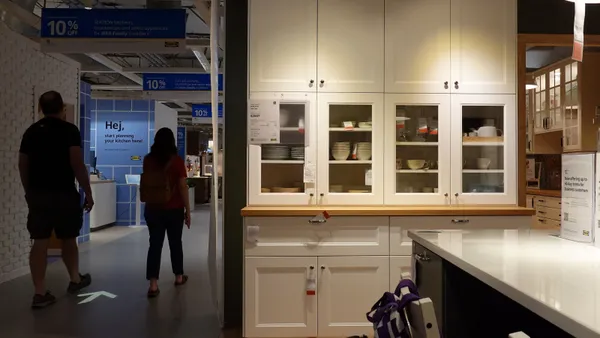Dive Brief:
- A commercial real estate firm in New York City has signed leases with four online retailers of menswear, The Wall Street Journal reported.
- Indochino and Jack Erwin will join current retail tenants Bonobos and Untuckit at 488 Madison Ave, located in a high foot-traffic area near St. Patrick's Cathedral and Midtown Manhattan.
- The establishment of brick-and-mortar stores by online retailers follows a growing trend of "clicks to bricks," appealing to consumer desire to try on physical products before purchasing.
Dive Insight:
I learned in my first economics lecture at a mega state university that supply and demand always works to find equilibrium. While that point may never actually be met for an extended period of time, both forces continue to work to find balance.
The opposing forces in the digital retail world — online sales and brick-and-mortar stores — are also working to find that balance. Under the concept of "clicks to bricks," a primarily online company creates an offline presence to support their online customers or gain new ones.
As the popularity of online shopping has grown, many traditional retail stores have struggled to capture the online market while maintaining their terrestrial presence. It has been a struggle to manage the different sales channels, and some retailers essentially now run two separate businesses — a traditional one with local stock and one with an online catalog.
The online offerings often provide a greater range of products for online customers and increasingly do not represent what is carried in the store. It is far less expensive to maintain an online catalog with centralized inventory than a myriad of stocking locations and the associated inventory and financial obligations. But retailers are looking for a way to stratify all customers in a quickly changing retail environment.
Notice the digital and print advertisements. There seems to be a constant battle between products available "in-store only" trying to drive store traffic, and "online only" trying to drive digital sales. No wonder the consumer is irritated and confused.
Now, traditional online merchants are working to create brick-and-mortar stores, hoping to appeal to a more traditional shopper and also acting as a showroom for their online presence. Amazon began the process of opening bookstores in an effort to sell more of their electronic products, realizing customers would like to see some of their products in action. Other retailers are opening stores to reach out to the segment of customers unwilling to risk an online order without seeing the products up close.
As a college professor, textbook publishers often contact me touting their latest and greatest offerings. Until several years ago, all of the review or desk copies supplied to me were print editions. When the publishers began to move to digital editions, all of the review copies were digital. In the past year, most publishers have begun to offer a choice. It seems that some professors and students like digital, and some like print. I’d call that an equilibrium of sorts.













